Categories > Guides and Tips

The Ultimate Guide to Marriage in Thailand
- Getting Married in Thailand: A Step-by-Step Guide
- Step 1: Fulfil eligibility requirements and declarations
- Step 2: Register your marriage
- Step 3: Determine the wedding costs
- Step 4: Decide when to get married
- Step 5: Hire a wedding planner
- Step 6: Start preparing for your wedding
- What are the common marital traditions and beliefs in Thai culture?
- What are the parts of the traditional Thai Wedding rite?
- FAQs about Thailand Marriage
From stunning tropical backdrops to rich cultural traditions, Thailand offers a truly magical setting for your wedding. However, before everything else, there are a few important things to know.
The process of getting married in Thailand varies depending on whether you’re a Thai national or foreigner.
Thai nationals must submit documents to their local district office, while foreigners must obtain a Certificate of Freedom to Marry from their embassy and have it translated into Thai.
In this guide, we’ll walk you through the legal requirements and cultural customs of getting married in Thailand, so you can have a smooth and stress-free experience.
Plus, you’ll learn the various types of Thai wedding ceremonies and the steps involved in planning a wedding in Thailand, from determining the wedding costs to hiring a wedding planner and finalising the details. Read on!
Getting Married in Thailand: A Step-by-Step Guide
Getting married in Thailand can be a magical experience, but it can also be a complex and confusing process, especially if you’re a foreigner!
Below, we’ll provide you with a comprehensive overview of the legal requirements for getting married in Thailand, including the eligibility criteria, registration process, and necessary documentation.
Step 1: Fulfil eligibility requirements and declarations
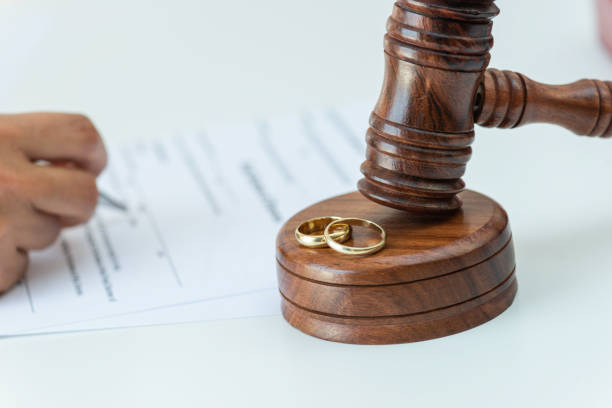
If you are a foreigner planning to get married with a local in Thailand, it is important to understand the legal procedures to ensure a smooth and stress-free wedding.
This can be done by obtaining a letter of affirmation of freedom to marry from your embassy in Thailand, or by obtaining a certificate of no impediment from your home country.
Step 1.1 Fulfill eligibility requirements
The first step in planning a legal wedding in Thailand is to fulfil the eligibility requirements. The minimum legal age for marriage in Thailand is 20 years old, according to the Civil and Commercial Code of 1985.
However, with parental permission, a person can get married at the age of 17.
Finally, it is important to note that same-sex marriages are not yet legally recognized in Thailand.
Step 1.2: Complete declarations at the embassy
Foreigners who wish to marry in Thailand must appear in person at their embassy with the following documents:
- A valid passport
- A certified copy of their birth certificate
- A certificate of single status (also known as a “no marriage” certificate) from their embassy or consulate in Thailand
- A declaration of freedom to marry from their embassy or consulate in Thailand
- If either partner has previously been married or widowed, they must present a certified copy of their divorce decree or the death certificate of their former spouse.
The registration will be handled by a Thai diplomatic or consular officer.
Step 1.3: Translate the declarations into Thai
Once the declarations have been completed, they must be translated into Thai. It’s important to have the translation done by a reputable translation office to ensure that it’s accurate and recognized by the Thai authorities.
Step 1.4: Authenticate the declarations
The next step is to take the translated declarations, along with copies of passports, to the Legalisation Division of the Consular Affairs Department. The consular official’s signature will be authenticated, which usually takes two days.
Step 1.5: Submit the documents to the district registrar
After the declarations have been authenticated, the documents can be submitted to the District Registrar. The marriage will be registered and a Thai marriage certificate will be issued by the registrar in accordance with Thai law.
| Important Note: Before getting married, you must have lived in Thailand for at least three days, and it is advised to allot four working days for the paperwork to be complete. |
Step 2: Register your marriage

After fulfilling the eligibility requirements, the next step in planning a legal Thai wedding is to register your marriage.
You can do this by submitting the necessary documents and completing the registration process at the local district office, also known as the Amphur.
| The required documents for marriage registration in Thailand include: ⮕ Passport or other valid identification ⮕ Proof of eligibility to marry, such as a letter of affirmation of freedom to marry or a certificate of no impediment ⮕ Birth certificate ⮕ If previously married, a divorce certificate or death certificate of the former spouse Important Note: Both parties must be present during the registration process and provide two witnesses who are at least 18 years old. |
The registration process may also include a brief interview with a registrar to confirm that the marriage is not being entered into for fraudulent purposes.
Once the marriage is registered, the couple will receive a marriage certificate in Thai. If an English translation of the certificate is required, it can be obtained at the Ministry of Foreign Affairs in Bangkok or at the couple’s embassy in Thailand.
It is important to note that the registration process may vary slightly depending on the couple’s nationality and individual circumstances.
Therefore, it is recommended to consult with the local district office or seek legal advice to ensure that all necessary requirements are fulfilled.
How to Deal with Prenuptial Agreements in Thailand

To create a prenuptial agreement that’s recognized in Thailand, both parties must seek legal counsel and have their agreement notarized. The agreement must be written in Thai and signed by both parties in the presence of two witnesses.
The prenuptial agreement can cover a range of topics, including the division of property and assets, financial support, and any other matters related to the marriage.
| Pro tip: While not required by law, signing a prenuptial agreement can provide couples with added security and peace of mind as they enter into marriage. It is important to seek legal advice and ensure that the agreement is properly executed to ensure that it is legally binding in the event of a divorce or separation. |
Step 3: Determine the wedding costs
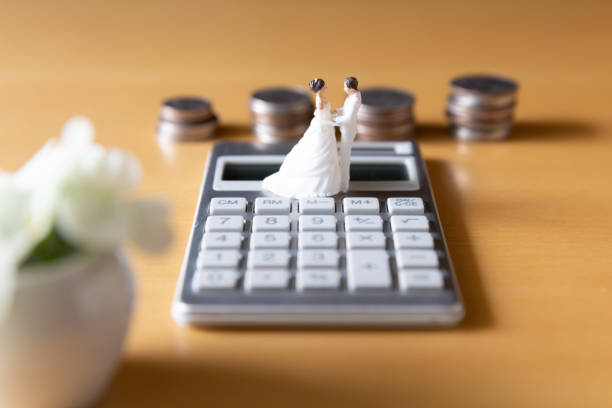
| The average cost of a Thai wedding can range from 200,000 to 500,000 Thai Baht (approximately $6,500 to $16,000 USD), depending on the type of wedding and the number of guests. |
Traditional Thai weddings, which typically involve a Buddhist ceremony followed by a reception, tend to be less expensive than Western-style weddings with a more elaborate ceremony and reception.
One way to save on costs is to choose an off-peak season for your wedding, which is typically between May and October. This may result in lower prices for wedding vendors and services.
Another way to save is to consider having a smaller, more intimate wedding with fewer guests. This can significantly reduce the costs of catering, venue rental, and other expenses.
Some common wedding expenses in Thailand include:
- Wedding venue rental
- Catering, including food and drinks for guests
- Decorations and floral arrangements
- Wedding attire for the bride, groom, and wedding party
- Photography and videography services
- Transportation for the wedding party and guests
- Entertainment, such as a live band or traditional Thai dancers
- Wedding favours or souvenirs for guests
- Wedding planner or coordinator fees
| Pro tip: To determine your wedding costs, it is helpful to research and compare prices for different vendors and services. It is also important to consider any additional costs, such as travel expenses for out-of-town guests or fees for obtaining necessary documents. |
Which party pays for the wedding in Thailand?

| In Thai culture, it is customary for the groom’s family to bear the majority of the wedding expenses. This includes the cost of the wedding ceremony, reception, and any associated costs such as catering and decorations. |
The bride’s family may offer to contribute financially, but it is not expected.In some cases, the bride and groom may also contribute financially to the wedding costs.
It is important for the families to discuss and come to an agreement on the wedding budget and who will be responsible for paying for each aspect of the wedding.
Step 4: Decide when to get married
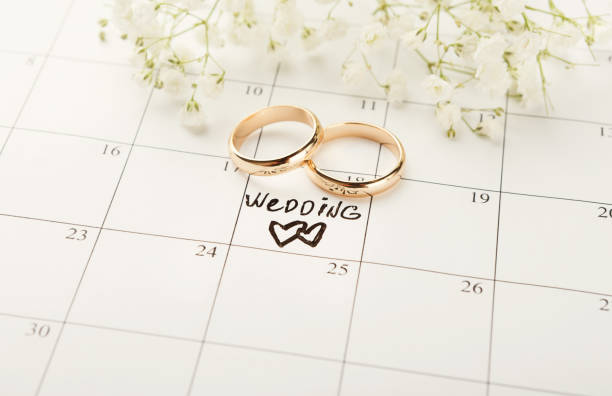
| The most popular months for weddings in Thailand are typically from November to February. |
This is considered the peak wedding season due to the cooler and drier weather conditions, which are more conducive to outdoor events. During this time, venues and vendors may be in high demand and may charge higher rates.
It’s important to book your venue and vendors well in advance to secure your preferred date and avoid last-minute availability issues.
The low season for weddings in Thailand is from May to October, which is the rainy season. During this time, there may be more limited options for outdoor wedding venues and activities, as there’s a higher likelihood of rain and typhoons.
However, choosing a wedding date during the low season can result in lower costs for wedding venues and vendors.
Step 5: Hire a wedding planner
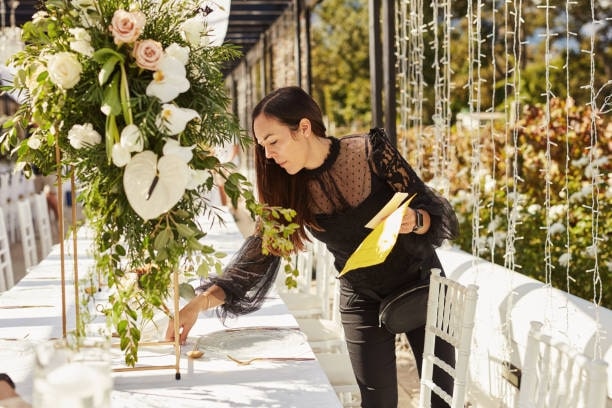
Hiring a wedding planner can be a great option for couples who want to ensure a smooth and stress-free planning process.
When choosing a wedding planner in Thailand, it is important to do your research and select a reputable and experienced planner who has a track record of successful weddings.
Look for reviews and testimonials from past clients, and consider scheduling a consultation with the planner to discuss your vision for the wedding and ensure that you feel comfortable working with them.
A good wedding planner should be able to provide you with a range of options for venues and vendors, based on your budget and preferences.
They should also be able to manage all of the logistical details of the wedding day, including the timeline, transportation, and coordination of the wedding party and vendors.
Step 6: Start preparing for your wedding
Once you have fulfilled the eligibility requirements, registered your marriage, determined the wedding costs, and hired a wedding planner (if desired), it’s time to start preparing for your wedding day. Here are some important steps to consider:
1. Look for a wedding venue
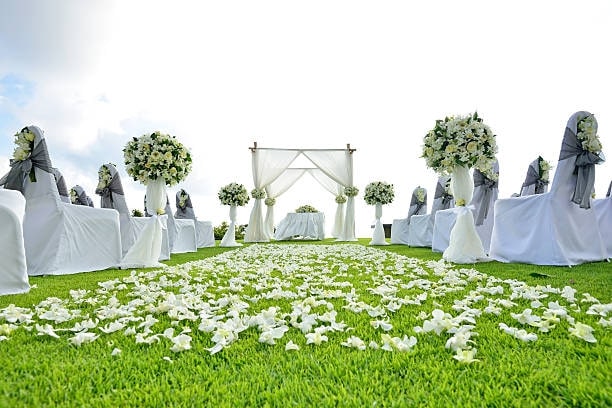
When looking for a wedding venue in Thailand, there are a variety of options to consider depending on your budget, style, and preferences.
Here are some popular types of wedding venues in Thailand:
- Beachside resorts: Thailand is known for its beautiful beaches, and there are many seaside venues that offer stunning views and luxurious amenities.
These resorts often have event spaces and wedding packages available, making the planning process easier.
- Traditional Thai temples: For a cultural and unique wedding experience, consider getting married at a traditional Thai temple.
These venues often feature ornate architecture and beautiful gardens, creating a memorable and meaningful setting.
- Private villas: Thailand has many private villas available for rent, often with beautiful ocean or jungle views. These villas can be a great option for a smaller, more intimate wedding.
- Rooftop venues: Thailand’s cities are home to many rooftop venues that offer beautiful skyline views and a modern, urban atmosphere. This is a great option for couples who want a city wedding.
- Garden venues: Thailand has many beautiful gardens and parks that can serve as a wedding venue, offering a natural and serene setting for your big day.
2. Take prenuptial photos

Taking prenuptial photos is a popular tradition in Thailand that many couples choose to participate in before their wedding day.
Prenuptial photos are typically taken by a professional photographer and are intended to capture the couple’s love and commitment to each other in a beautiful and artistic way.
Here are some tips for taking prenuptial photos in Thailand:
- Choose a location: Thailand has many beautiful locations to choose from, such as beaches, temples, gardens, and historical sites. Consider your personal style and preferences when selecting a location.
- Hire an interpreter: This is especially important if you don’t have a good grasp of Thai and you want to express your requirements for the shoot clearly.
- Hire a professional photographer: Look for a photographer with experience in prenuptial photography and a portfolio that matches your style and preferences. It’s also important to discuss pricing and packages in advance.
- Plan your outfits: Consider coordinating your outfits with each other and the location. Light, flowy fabrics are popular for beach and garden settings, while traditional Thai clothing can be a great choice for temple settings.
- Consider hair and makeup: Many photographers offer hair and makeup services as part of their prenuptial photo packages. Alternatively, you can book a separate appointment with a hair and makeup artist.
By following these tips, you can capture beautiful and meaningful prenuptial photos that will be a cherished memory of your engagement and commitment to each other.
3. Pick a wedding dress

Choosing a wedding dress can be one of the most exciting parts of wedding planning in Thailand.
Here are some tips to help you pick the perfect dress for your special day:
- Consider the weather: Choose a wedding dress that is comfortable and breathable in Thailand’s tropical climate, such as lightweight fabrics like chiffon or organza.
- Think about the location: If you’re getting married on the beach, consider a flowing, bohemian-style dress, while a traditional Thai wedding may call for a more elaborate, embroidered gown.
- Consider your personal style: Your wedding dress should reflect your personal style and make you feel beautiful and confident. Look for dresses that compliment your body type and highlight your best features.
- Set a budget: Wedding dresses can vary in price, so it’s important to set a budget and stick to it. There are many options for affordable wedding dresses in Thailand, including local designers and bridal shops.
- Shop early: It’s recommended to start shopping for your wedding dress at least 6 to 8 months before your wedding date to allow time for alterations and fittings. This also ensures that you have enough time to find the perfect dress without feeling rushed or stressed.
4. List the menu for your wedding reception
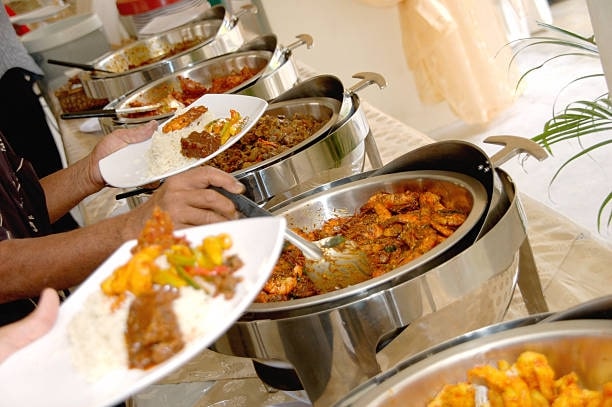
The menu for a wedding reception in Thailand often includes a variety of delicious and flavorful dishes that showcase the country’s diverse cuisine.
Here are some popular local dishes that you might consider including in your wedding reception menu:
| Appetisers: ⮕ Chicken satay with peanut sauce ⮕ Thai fish cakes ⮕ Crispy pork belly with chilli sauce ⮕ Spicy papaya salad | Soups: ⮕ Tom yum soup with shrimp or chicken ⮕ Coconut milk-based chicken soup (Tom kha gai) |
| Main dishes: ⮕ Pad Thai (stir-fried rice noodles with chicken or shrimp) ⮕ Green curry with chicken or beef ⮕ Massaman curry with beef or chicken ⮕ Stir-fried chicken with cashew nuts ⮕ Grilled fish with chilli-lime sauce | Sides: ⮕ Stir-fried vegetables (pak choi, broccoli, or mixed vegetables) ⮕ Steamed jasmine rice ⮕ Sticky rice |
| Desserts: ⮕ Mango sticky rice (sweet sticky rice with fresh mango and coconut milk) ⮕ Fried bananas with honey and sesame seeds ⮕ Thai-style custard | Beverages: ⮕ Thai iced tea or coffee ⮕ Fresh fruit juice (pineapple, watermelon, or mango) ⮕ Beer or wine (if alcohol is being served) |
It’s important to work with your caterer or wedding planner to customise the menu to your preferences and dietary restrictions.
By offering a variety of flavorful dishes and refreshing beverages, your wedding reception in Thailand is sure to be a memorable culinary experience for you and your guests.
What are the common marital traditions and beliefs in Thai culture?
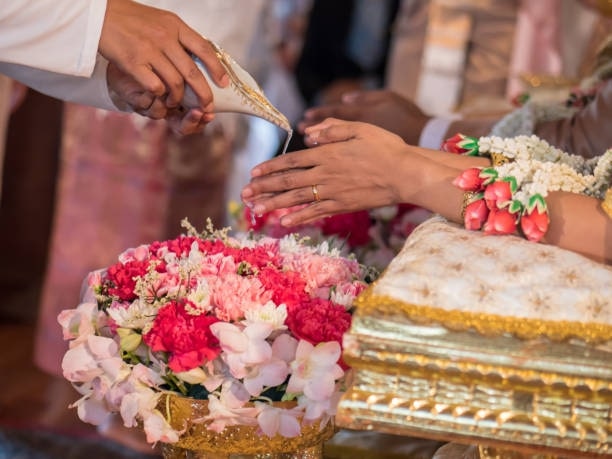
Thai marriage culture is steeped in tradition and beliefs that are deeply rooted in the country’s history and cultural heritage.
From the practice of arranged marriages to the importance of family and Buddhism, Thai marriages are filled with rituals and customs that reflect the values and beliefs of the society.
1. Family and social status are important
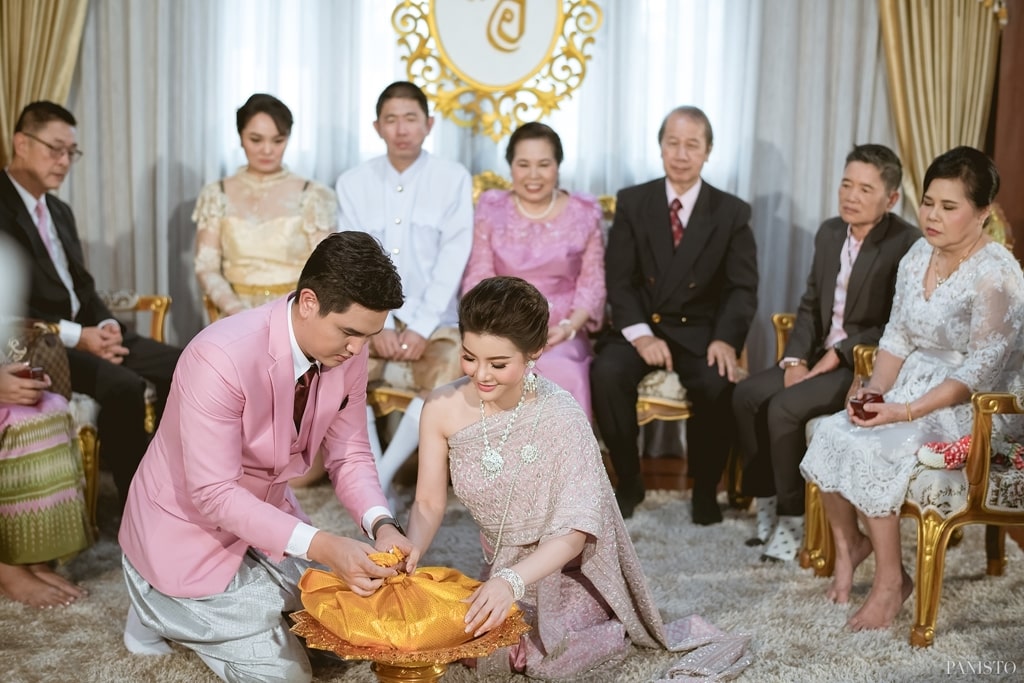
In Thai marriage culture, the importance of family and social status cannot be overstated. Marriage is often viewed as a way to strengthen family ties and build social connections, and the involvement of families in the match-making process is common.
Family approval is often a crucial factor in the decision to marry, and couples may need to gain the blessing of their parents and extended family before proceeding with the wedding.
Parents may even arrange marriages for their children, with the couple having little say in the matter.
Social status is also a significant factor in Thai marriage culture, with families often seeking to marry their children into families of equal or higher social status.
This is reflected in the practice of sinsod, where the groom’s family provides a dowry or payment to the bride’s family as a way to show respect and acknowledge their social standing.
Arranged marriages are also motivated by the desire to maintain or increase social status within the community.
By marrying into a prominent family or a family with significant wealth, a person’s social status can be elevated, leading to greater respect and opportunities within their social circle.
2. Thais also follow Chinese engagement rituals (tea ceremony)
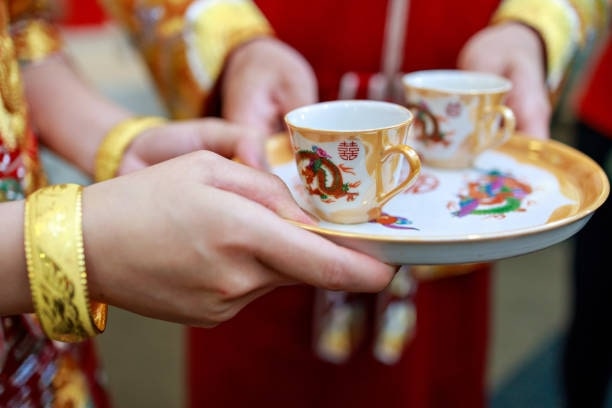
In a Chinese tea ceremony, the groom and his family visit the bride’s family to offer them tea as a sign of respect and gratitude. The tea is served in small cups, and the bride and groom kneel in front of their respective parents while presenting the tea.
This is also a way for the couple to receive blessings and well-wishes from their elders.
If a Thai family chooses to include a Chinese tea ceremony in their engagement or wedding celebrations, it is often seen as a way to honour and respect their cultural roots and to pay homage to their ancestors.
The ceremony is also a way for the couple to show their respect and gratitude to their parents, and to receive their blessings as they start their new life together.
3. Thai engagement ceremonies can be a mixed ceremony
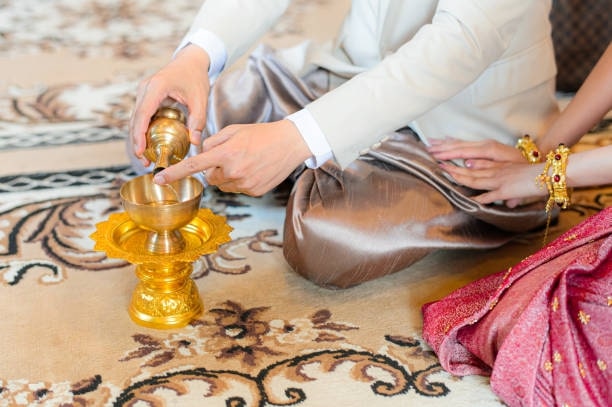
It is not uncommon for engagement ceremonies in Thailand to include elements from both traditional Thai and other cultural traditions, depending on the couple’s personal preferences and cultural background.
For example, a Thai couple with Chinese heritage may choose to include elements of a Chinese tea ceremony as part of their engagement celebration.
Meanwhile, a couple with Indian heritage may incorporate traditional Indian rituals such as the exchange of garlands or the tying of the mangalsutra.
Some couples may also choose to incorporate more modern elements into their engagement ceremonies, such as personalised vows or exchanging gifts with each other.
Ultimately, the beauty of engagement ceremonies in Thailand is that they can be tailored to reflect the unique backgrounds and preferences of the couple.
It serves as a symbol of the couple’s commitment to each other and the beginning of their journey towards marriage.
4. Buddhism has a prominent role in Thai marriage culture
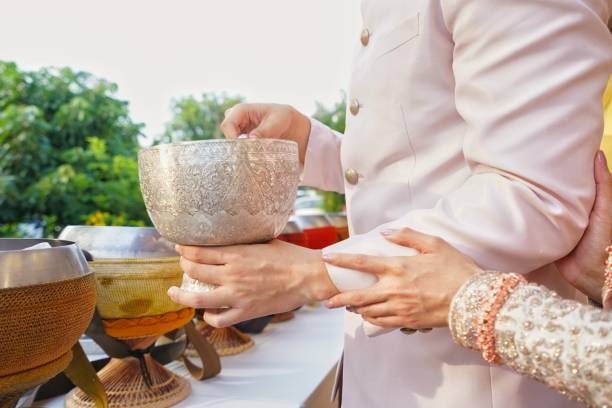
Buddhism has a significant influence on Thai marriage culture, as the majority of Thais are followers of Theravada Buddhism.
Buddhist principles and rituals are incorporated into many aspects of Thai weddings, including the pre-wedding and wedding ceremonies.
Since making merit through acts of generosity and kindness is also an important aspect of Thai Buddhism, certain acts are often incorporated into Thai weddings.
This includes the practice of offering alms to monks, making donations to temples or charitable causes, and performing other acts of merit-making.
5. There are different types of Thai wedding ceremonies
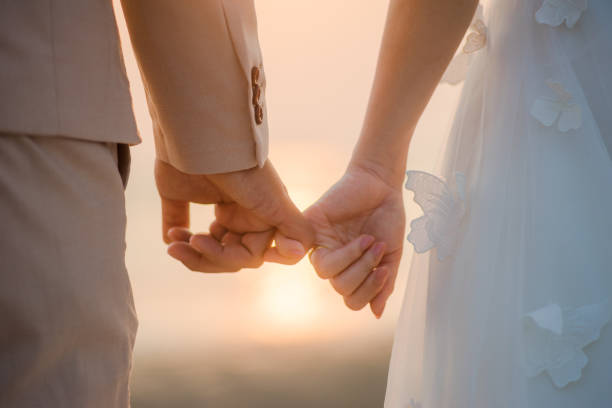
Thailand is a country rich in diverse cultural traditions, and this is particularly evident in their wedding ceremonies. Thai weddings are not just one singular event but can vary depending on the couple’s preferences and regional customs.
1. Thai Traditional Wedding
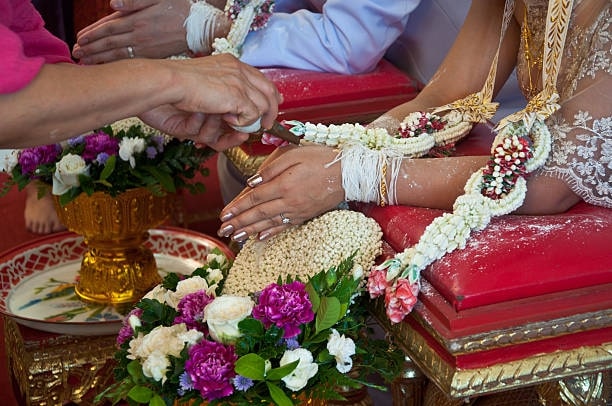
The Thai Traditional Wedding is a beautiful and culturally rich ceremony that has been passed down through generations.
It includes various rituals and customs that are symbolic of Thai beliefs and values, such as the Khan Mak procession and the Sai Monkhon ceremony.
In this type of wedding, the couple pays respect to their families, ancestors, and Buddhist traditions.
2. Modern Wedding
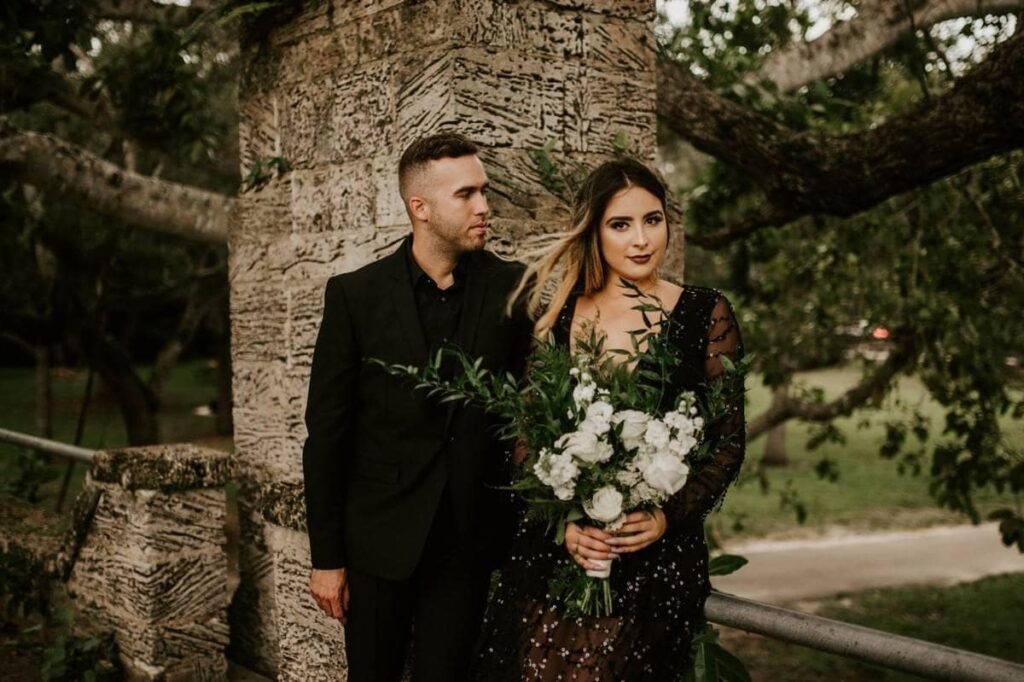
A modern wedding can mean different things to different people, but in general, it refers to a wedding that incorporates contemporary elements and trends while still honouring traditional elements and customs.
From wedding websites to online invitations and social media updates, couples are using technology to streamline wedding planning and share their special day with loved ones.
Some couples also opt for non-traditional wedding attire, such as jumpsuits or modern-style wedding dresses.
Finally, interactive experiences that engage guests and make the wedding more memorable are included in these modern wedding ceremonies. This can include photo booths, interactive food stations, and unique entertainment options.
3. Christian Wedding
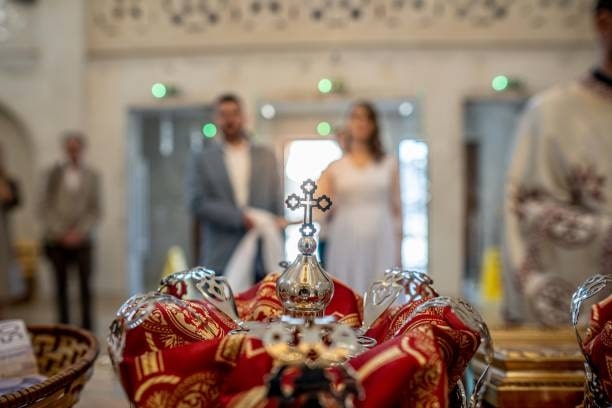
In Thailand, Christian weddings are becoming increasingly common, particularly among couples who share a Christian faith or who are looking for a traditional and solemn wedding ceremony.
Christian weddings in Thailand are typically held in churches, which are often ornate and decorated with beautiful stained glass windows and religious artwork.
The wedding ceremony itself is similar to those held in other parts of the world, and typically involves the exchange of vows and rings, readings from scripture, and a blessing from the officiant.
Additionally, the ceremony may include other Christian traditions, such as the lighting of candles or the performing of a unity ceremony.
After the ceremony, the couple and their guests will often celebrate with a reception that includes food, music, and dancing.
What are the parts of the traditional Thai Wedding rite?
If you are not familiar with the numerous steps involved in a traditional Thai wedding, don’t worry! Below, we’ll provide you with a detailed explanation of the various processes that take place during a Thai wedding ceremony.
1. Couple makes merits to ensure a prosperous married life
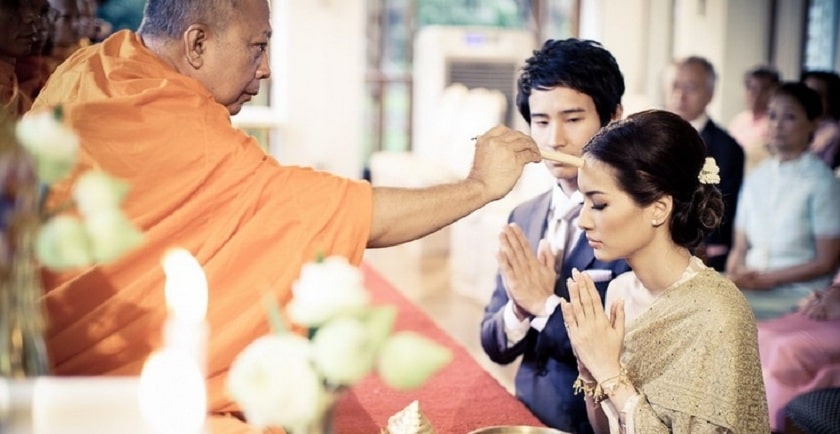
To ensure a prosperous married life, the initial step of a Thai wedding is to commence with a religious ceremony, which involves making merit.
On the morning of the wedding day, the bride and groom must invite an odd number of monks, typically nine as it is considered a lucky number in Thai culture, to their home and offer them food.
The monks will then perform a blessing ceremony for the couple, wishing them happiness and prosperity in their married life.
2. The groom and his family conduct the Khan Maak procession
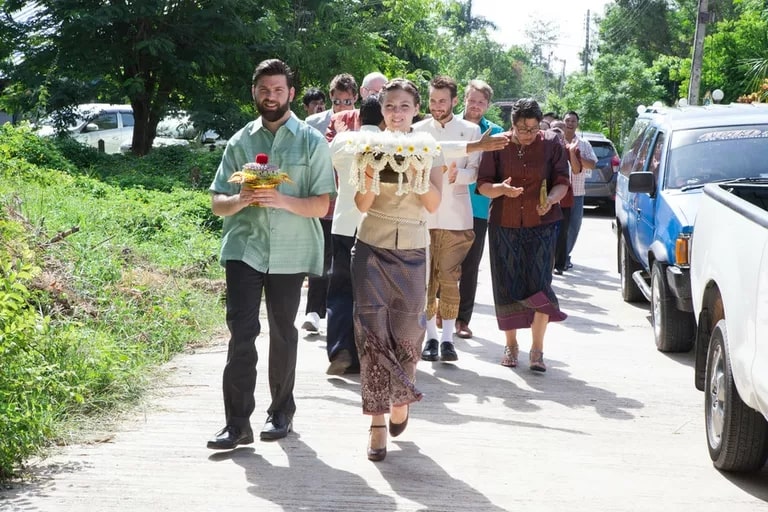
Khan Maak Procession is an important part of the Thai wedding ceremony, as it signifies the groom’s willingness to commit to the bride and her family.
The groom and his family and friends dress up in traditional Thai attire and carry gifts and offerings, such as flowers, fruits, and sweets, to the bride’s family.
The procession is usually accompanied by music and dance performances, creating a festive and joyful atmosphere.
3. The groom is barred
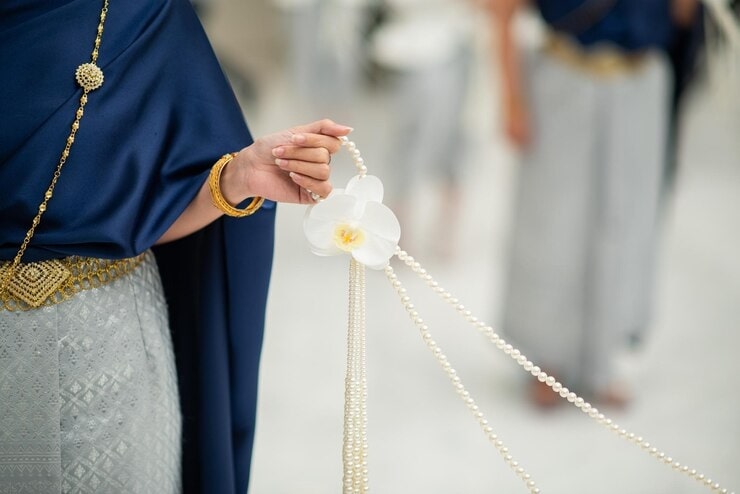
In this phase, the groom is barred from entering the bride’s house until he passes through a symbolic set of doors, which include a pink gold door, a silver door, and a gold door.
The bridesmaids and bride’s family built these doors and playfully prevented the groom from passing easily.
Lastly, the groom must give money or do something that the bridesmaids and family want before he is allowed to enter. This could include shouting “I love you” to the bride.
4. Couple exchanges engagement rings
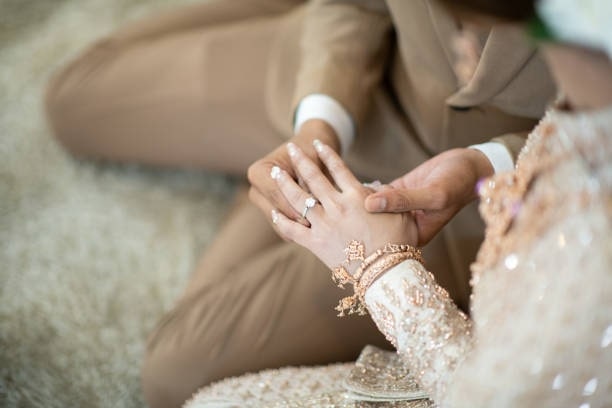
In Thailand, the couple typically exchanges engagement rings as a symbol of their commitment to each other.
The exchange of rings is usually part of the engagement ceremony, which may take place on the same day as the wedding ceremony. The rings are typically worn on the ring finger of the right hand, as opposed to the left hand in Western cultures.
Engagement rings in Thai tradition may be simple or ornate, and they may feature precious stones or other decorative elements.
5. The groom and his family present the sinsod or dowry
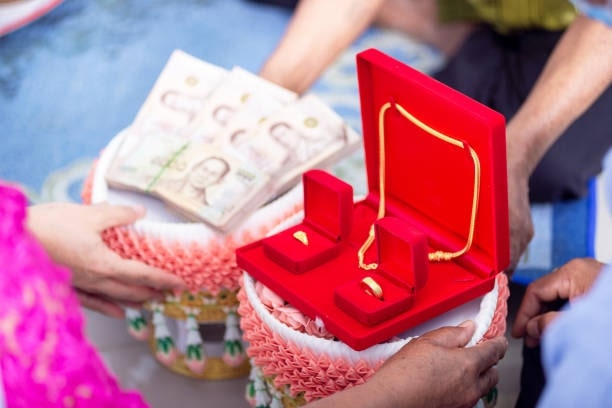
Once the groom has retrieved the bride from her chamber, the parents of the bride will proceed to count the sinsod or dowry.
In Thai culture, sinsod is an important tradition that plays a significant role in marriages. It’s given by the groom’s family to the bride’s family as a sign of respect and acknowledgement of their social status.
The dowry can vary depending on various factors such as the social status of the families and the education and career of the bride. The amount is negotiated by the parents of the couple and can include money, gold, and other valuable items.
Sinsod is seen as a way to strengthen the relationship between the two families and symbolises the groom’s commitment to take care of the bride and her family.
The next step involves spreading a mixture of green peas, sesame, popped rice, and paddies onto the dowry.
Following this, the mother of the bride will take the dowry and place it on her shoulder, acting as if it’s incredibly heavy due to the significant amount of money inside.
6. Marriage and Sai Monkhon takes place
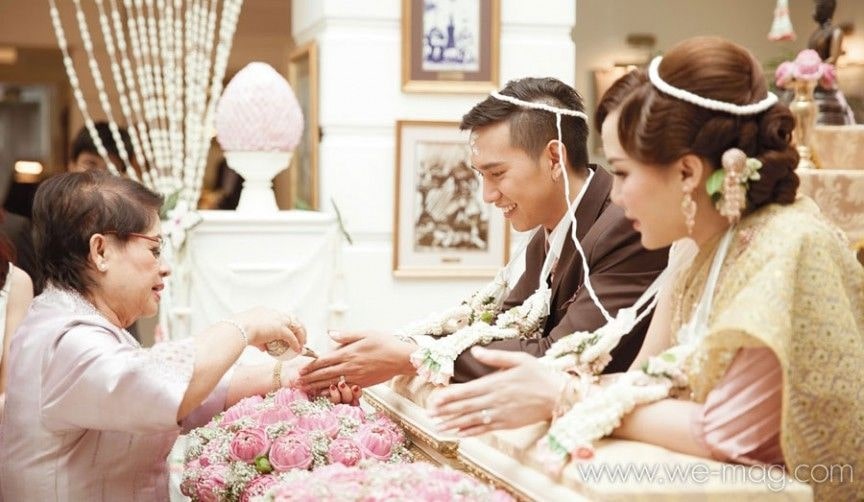
In the Sai Monkhon ceremony, the groom and bride kneel beside each other while a blessed string is draped from the head of the groom to the head of the bride which connects the two.
The blessed string is usually made of white thread and is held by a group of married couples or elders who are considered to have successful marriages.
It is believed that the string symbolises the bond between the couple and the elders are there to offer their blessings and well wishes for a long and prosperous marriage.
7. Engagement ceremony takes place
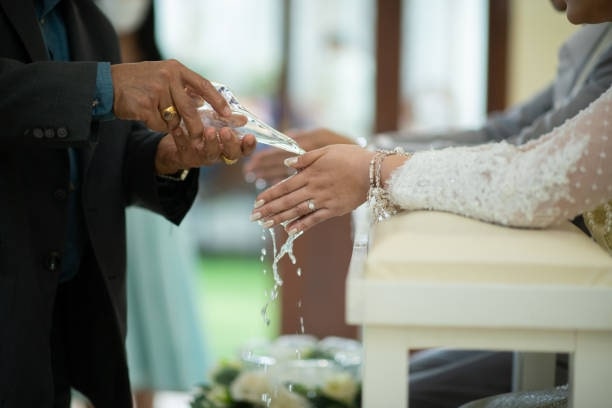
In modern times, it has become quite common for Thai couples to hold their engagement ceremony on the same day as their wedding. This typically takes place at the bride’s family home, and the groom arrives with his family bearing gifts.
The ceremony itself involves a series of symbolic rituals, including the “rod nam sang” ceremony, where the couple’s hands are blessed with water.
Rod Nam Sang ceremony is an important part of the Thai wedding tradition, as it symbolises the couple’s commitment to each other and their desire for a happy and prosperous life together.
During the Rod Nam Sang ceremony, the bride and groom kneel or sit facing each other while their hands are held together in a wai (a gesture of respect).
The guests then pour water over the couple’s hands while giving them blessings and well-wishes for their future life together.
This ceremony is typically followed by a feast or banquet, where family and friends come together to celebrate the couple’s engagement.
8. Thai wedding reception starts
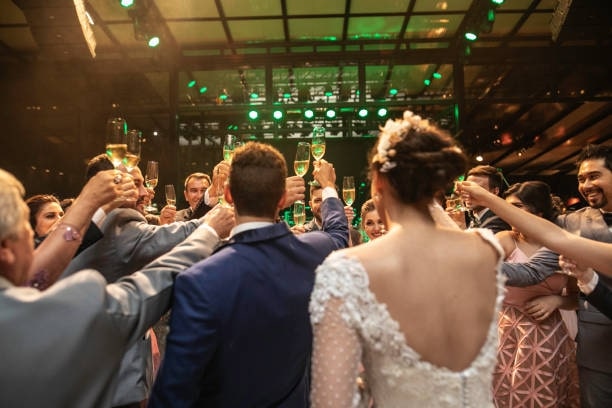
The reception usually begins with a grand entrance of the newlyweds, who may wear a different outfit than what they wore during the ceremony. They are often accompanied by their parents or close relatives.
During the reception, there is usually a lot of food, music, and dancing. Traditional Thai dishes are often served, along with other popular dishes. Guests are encouraged to eat, drink, and be merry.
There may also be speeches and toasts given by the bride and groom’s family members and friends. The couple may also have their first dance as newlyweds.
9. Couple will be escorted to the nuptial bed
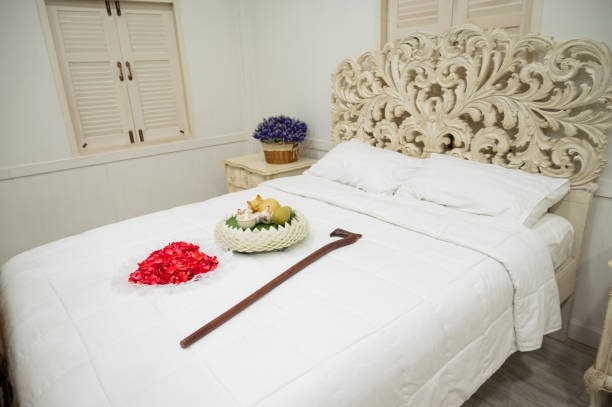
The final event of a Thai wedding may take place in the bedroom, but it’s not what one may expect! The bride’s parents will escort her to the room and impart lessons about married life to the newlywed couple.
Typically, the bed is decorated with flower petals and a brass tray containing traditional symbols, two pillows and auspicious things including mortar & pestle, winter melon, an old male cat, beans, paddies and a bowl of rainwater.
According to tradition, the couple should sleep with these items in the bed for three days — but this is rarely done nowadays. The parents usually prepare the bed and explain the symbols before leaving the couple alone.





